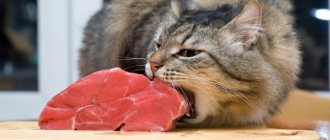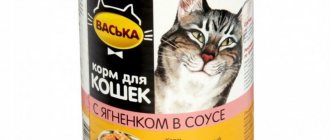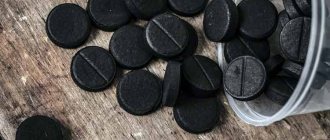Natural feeding of cats also has its own number of advantages and disadvantages compared to feeding with ready-made food.
The main advantages of such a diet are that the owner knows which product was used in the preparation; it is also possible to regulate their quantity.
Another positive factor is that the owner can independently regulate the amount of all nutrients - proteins, lipids, carbohydrates, vitamin and mineral complexes, choosing the optimal value for his mustachioed pet.
The disadvantages of feeding cats natural food are:
- purchasing expensive quality products;
- time to prepare food for the animal.
The most important disadvantage of natural feeding
Calculating a natural feeding ration is a procedure that requires a serious approach, and the calculations are quite complex. Pet owners often simply do not have enough knowledge about the nutritional needs of the cat's body. In addition, the declared content of various substances in products is the average temperature in the hospital, and with a natural type of food you cannot be completely sure that the pet is getting everything it needs.
Also, when calculating the diet, it is necessary to take into account all the characteristics of the animal, the presence of chronic diseases and physiological conditions (pregnancy, lactation, active growth, age-related changes).
When feeding natural food, it is not recommended to make large reserves of food; it is advisable to prepare a portion for 1-2 doses. However, it is possible to prepare food for a longer period by using portion freezing, but this is a task that also requires special knowledge from the animal owner.
If there is a deficiency or excessive content of some important elements, there is a risk of developing dangerous chronic diseases - kidney failure, disorders of the cardiovascular system, liver disease and other pathologies. In addition, when choosing natural components of future food, it is important to be confident in their quality.
Before you start feeding your cat natural food, you need to decide which products must be present in the food, and which type is preferable for a particular type of pet.
Is it possible to clean a cat's ears with hydrogen peroxide?
In order for the cat to remain healthy and active, have a strong immune system and not be bothered by various diseases, it is very important that the owners take sufficient care of it. Particular attention should be paid to cleaning your pet’s ears, since hearing impairment is critical for cats. If you do not clean your cat's ears in a timely manner, the wax plug can put pressure on the ear plug and the animal's hearing can be significantly reduced. Can I clean my pet's ears with hydrogen peroxide?
Oxygen peroxide is believed to soften ear plugs, making ears easier to clean. However, do not forget that the solution dries the skin, so if the cat’s ears need to be cleaned only for hygienic purposes, then it is best to use regular saline solution, since dryness in the ear canals can provoke the production of wax. A cotton swab is soaked in a saline solution and the inner ear canals of the cat's ears are gently wiped. You can also use chamomile decoction or regular boiled water instead.
You can also purchase solutions specifically designed for cleaning pets’ ears at veterinary pharmacies.
Hydrogen peroxide can be harmful to the skin inside your cat's ear. Due to the fact that delicate skin dries out, it is more susceptible to cracks, which in turn can cause wounds and ulcers.
Meat
A product that should be present in any diet of a predatory animal, but its type must be clearly defined.
Fatty types of meat should not be given to cats, especially for cat breeds such as Scottish Fold and British. When there is an excess of lipids, inflammatory processes occur in the pancreas.
It is advisable to choose turkey, chicken and quail meat. It is possible to introduce horse meat and rabbit meat, but pork and beef, and moreover lamb, are prohibited.
It is also important to give not tenderloin, but trimmings - the meat should have veins and tendons, since meat is pure protein, and the veins are collagen, which a cat in the wild receives from the paws, beaks and joints of birds and mice.
Experts do not recommend feeding raw meat to your domestic cat, as there is a high risk of various infectious diseases until the meat has been heat-treated. You should not give your pets smoked or fried meats.
Onion and garlic
A cat usually does not chew garlic or onions. But some owners try to feed their pet garlic in order to destroy worms.
Onions and garlic are hidden in products - cutlets, pilaf, soup, baby food. One serving of such food will not harm the cat, but poisons (sulfur compounds) accumulate in the body, causing the destruction of red blood cells and symptoms of chronic poisoning.
The cat is attracted to meat, but if you leave a bowl with the remains of the marinade, it can eat onions soaked in juice
Bran
Various cereals are a mandatory daily menu item; professionals recommend adding them to the diet of a domestic cat. But, with frequent and large consumption of grain products, there is a risk of developing disorders in the pancreas, genitourinary and endocrine systems. Therefore, veterinarians and breeders recommend using an alternative to cereals - bran, rich in vitamins.
If the owner decides to add cereals to the animal’s diet, it is necessary to clearly know which cereals are healthy and which ones are best avoided. You cannot feed your cat buckwheat and wheat; it is better to give preference to rice, semolina and oatmeal.
Sausage
For some reason, it is believed that sausage is a favorite treat for dogs and cats. But many animals refuse to eat it unless they are too hungry.
Why is giving your cat any sausages or sausages a bad idea? It's not about soy and the by-products from which they are often made. And in spices. This includes salt, onions, garlic, and pepper. Preservatives and dyes, which the human liver can easily neutralize, can be very dangerous for a cat.
The most dangerous types of sausages are fatty ones (raw smoked). Just one piece can cause uncontrollable vomiting due to inflammation of the pancreas and stomach walls.
Fish
Giving cats fish must be dosed, observing certain norms. The cat's digestive system is not accustomed to the composition of amino acids and minerals contained in fish (in the wild, cats do not catch their own fish), which can cause kidney disease and urolithiasis.
Feeding your cat raw fish and river fish is prohibited; it is advisable to choose low-fat varieties of sea fish and boil it first. River fish, and even raw fish, contains a large number of helminths and substances that interfere with the normal absorption of nutrients, unlike boiled fish. Also, most river fish contain a specific enzyme, thiaminase, which destroys vitamin B1.
When choosing fish, the owner should focus on the following types: salmon, pink salmon, salmon, hake, catfish, mackerel tuna.
Mechanism of action
Doctors confirm that there really can be an effect. The mechanism is very simple; sunflower oil helps with constipation indirectly. The body reacts to the intake of pure fats by releasing bile, which, in turn, is a stimulator of peristalsis. Other vegetable fats also work this way, and the effect of sunflower fat is the weakest. Olive oil has the most pronounced choleretic effect. You can also use castor oil, but it is not often at hand.
Milk products
One of the most controversial items on a cat's menu. Most professionals do not recommend giving it, but many owners use it in their cat's daily diet.
The presence of dairy products on the menu rather depends on the cat’s lifestyle. If from childhood she was fed milk, cottage cheese, kefir and other fermented milk products, then she will not have diarrhea, and even to some extent this will be beneficial for her. And if a significant amount of time has already passed since the end of the lactation period, and the cat did not eat dairy products at that time, in this case, indigestion and profuse diarrhea are guaranteed.
What you should know
Sunflower oil is a very popular remedy for constipation; people recommend it to each other, without taking into account that the condition of the body can be very different for everyone. A spoonful of oil a day will not harm a healthy person; it will only slightly stimulate intestinal motility. But this rule only works if a person does not suffer from chronic, atonic constipation, irritable bowel syndrome, or cholelithiasis. In this case, you can safely experiment with sunflower oil, trying out its laxative properties.
Vegetables
An essential part of the diet, especially for cats suffering from constipation. But it is not advisable to feed a cat with diarrhea vegetables.
Vegetables contain a large amount of vitamins and microelements necessary for the body. You can feed your pet raw vegetables, they contain all the nutrients. Boiled vegetables lose their properties in terms of vitaminizing the body, but for cats with problems with the digestive tract, it is better to boil vegetables due to the fact that they irritate the mucous membrane of the stomach and intestines less.
As a rule, cats eat vegetables with little desire, so experts recommend mixing boiled grated carrots, pumpkin, beets, cabbage, broccoli with boiled chicken breast. You need to be as careful as possible when adding vegetables to your cat's diet. Beets can cause vomiting or loose stools, white cabbage can cause increased gas formation.
Why do cats purr?
Modern science has figured out how cats purr. It is much more difficult to explain what it means when a cat purrs. There are many theories and they all have one reason or another. But most scientists and veterinarians agree that cats purr when everything is fine with them, when they want to show their affection or defenselessness.
It is believed that the habit of purring appears in cats almost from birth. Indeed, you can hear cats purring as early as two days of age. In this way, little kittens let you know that everything is fine with them, everything is in order. They can purr happily even when they are eating. Sound has a calming effect on them, which is why cats purr when playing with them.
Why do cats purr when they get older? It is believed that this is an important moment of communication between animals. For example, a dominant cat signals to its subordinate that it is in a good mood. The cat “tells” the cat that she feels sympathy for him. Sometimes I wonder why cats purr when they are attacked. In fact, there is nothing strange here; the cat is in this way trying to show the attacker that they do not pose a threat, are weak, defenseless and should not be touched. This works most often when cats attack each other.
It should be noted that while a cat is purring, it is impossible to listen to the heart and lungs. Therefore, veterinarians often turn on the water in the office during examinations. Perhaps the cat is disturbed by the sound of flowing water, it gets scared and stops purring. This pattern confirms the theory of why cats purr - they do it when they feel good and calm.
Various natural supplements
Expert felinologists recommend that cat owners add flaxseed or buckwheat bran, dried kelp, vegetable oils (except sunflower), and fish oil to their animals’ main diet. Sunflower oil is not harmful to the cat's body, it is just not as effective as other types of vegetable oils.
All these components can be added regularly or from time to time. A small pinch of dried kelp is enough to enrich the body with iodine with each feeding, and the use of sesame, flaxseed and olive oils allows fat-soluble vitamins that enter the body with other foods to be better absorbed.
However, before introducing these additives into the diet, it is necessary to examine the animal and consult with a veterinarian about the selection of food.
Can cats have oil?
Veterinarians allow the cat to be given oils of animal and plant origin to saturate the pet’s body with vitamins and fatty acids. Only dosed consumption will have a positive effect. If you overeat, your cat may experience diarrhea, lethargy, and an allergic reaction. Veterinarians prohibit giving this natural product in its pure form, only in combination with cereals, vegetables, meat and fish.
Alcohol
Most cats will not drink alcoholic beverages. But some owners themselves pour vodka into animals in order to “treat” them! Alcohol poisoning is very dangerous for cats and can lead to death.
Cirrhosis of the liver develops in cats due to chronic consumption of ethanol.
What about beer, you say? After all, it is low-alcohol or completely non-alcoholic. No. Not only ethanol is dangerous for cats, but also hops. Hops can cause fever, shortness of breath, rapid heart rate and even death.
Take care of your pets!
Kitty, you will feel bad, don’t do this!
Read about whether you can feed your cat only dry food.
For those to whom this article seemed like an advertisement for industrial food, as well as those who believe that without the listed products a cat can only die of hunger: we are preparing natural food for cats.
Let your four-legged pets live long and enjoy excellent health! Subscribe to the Zootopia channel - these are daily publications about different pets.
- Why do cats purr?
- How many years do cats live?
- Is it possible to clean a cat's ears with hydrogen peroxide?
- Can cats eat butter?
- Is it possible to worm a nursing cat?
COVID-19: what myths can harm your health?
Concern 1: Is it true that if I have a runny nose and phlegm during a cold, then I cannot be a carrier of coronavirus infection? Is coronavirus a dry cough without a runny nose?
Igor Nikonorov
Head of the scientific and organizational department of the Federal State Budgetary Institution “Influenza Research Institute named after. A. A. Smorodintseva" of the Ministry of Health of Russia, Candidate of Medical Sciences
– Indeed, a dry cough or cough with a small amount of sputum is noted in 80% of cases with COVID-19.
This is one of the clinical symptoms of an acute respiratory viral infection, along with fever, shortness of breath, and fatigue. Concern 2: If an infected person sneezes in front of me or walks at a distance of up to 3 meters, then I just need to slow down and the infection will just fall to the ground and not harm me?
- That's not entirely true. When sneezing, coughing, or talking, an “infected zone” of saliva, mucus, and sputum with a high concentration of the pathogen is formed around the patient. Large droplets of such an aerosol disperse at a distance of up to 2–3 meters and settle quite quickly on various surfaces. Smaller aerosol particles can remain suspended for quite a long time due to the slightest air movements. Naturally, this creates a greater threat indoors than outdoors. Hence the recommendations to stay at a distance from each other and use personal protective equipment. Of course, both influenza and coronavirus viruses are not particularly stable in the external environment. But for some time they can remain viable not only in the cold, but also at room temperature, but in the sun, from exposure to ultraviolet radiation, they die faster.
How to protect yourself from the virus in the store and when ordering food at home, read here.
Concern 3: Is it true that the incubation period is 28 days?
– This can indeed happen, but this is not the rule, but rather an exception to it. Typically, the incubation period takes from 2 to 14 days, and on average 5–7 days.
Concern 4: Coronavirus is said to be similar to HIV. This is true?
- No, that's not true. At the end of 2002, the SARS-CoV coronavirus appeared, and in 2012 the world encountered a new coronavirus - MERS (MERS-CoV) - while searching for drugs for treatment, a positive effect was discovered when using drugs to treat HIV infection. But this does not make viruses similar. Such rumors come from a scientific publication in which the result was incorrectly interpreted. The publication was almost immediately retracted.
In the current conditions, when the new virus began to be urgently studied in various laboratories around the world, scientific publications often began to be published non-peer-reviewed, that is, not tested by other specialists from a certain field. Because of this, many inaccurate and erroneous results remain in the articles. According to TASS, calculations by molecular biologists from the University of Michigan showed that SARS-CoV-2, in principle, could not “inherit” RNA sections from any other viruses, including HIV.
Concern 5: Some believe that the coronavirus is a biological weapon specially bred in a laboratory.
– This is another conspiracy theory. People who would deliberately make biological weapons would think about how to protect their own nation and would first develop a vaccine. But we see the number of infected people in the USA, China and other countries. The same Michigan researchers concluded that the genome segments of the new coronavirus were most similar to similar parts of the genome of the RaTG13 coronavirus, the putative ancestor of SARS-CoV-2, which infects bats. This suggests that the virus arose as a result of the natural evolution of the coronavirus, and not through the exchange of genes with other viruses.
Concern 6: Is it true that the coronavirus contains 50 strains of influenza?
– This is a continuation of the theory about an artificially bred virus, and it has nothing to do with reality. Flu and coronavirus are different infections and are caused by different viruses.
Concern 7: There is a theory that bananas may be infected with coronavirus.
– Such a story was circulating in instant messengers, but it is not true.
Concern 8: They write on the Internet that a solution of soda or lemon juice diluted in water can be used as a preventive measure against coronavirus. You just need to drink these solutions in small portions 3-4 times a day. Is this really so?
– Another pseudo-memorandum has leaked onto the Internet that the pH of the virus is from 5.5 to 8.5, and some “experts” suggest drinking alkaline solutions to neutralize the virus, while others suggest drinking acidic ones.
This is another piece of information pulled out of thin air. SARS-CoV-2 is stable over a wide range of acidity (3–10 pH). This means that neither acids nor alkalis will affect it. Drinking soda solutions and lemon drinks to protect against coronavirus is useless.
For information
pH is an indicator of acid-base balance. A pH value less than 7 is considered an acid, and a pH greater than 7 is considered an alkali. The coefficient 7 itself means neutral pH, which includes water.
Concern 9: Is it true that treating the entire body with ethanol or chlorine-containing products can kill the coronavirus?
– A strange and even dangerous proposal. To clean your hands, it is better to use sanitary wipes, including alcohol wipes. And this is if it is not possible to wash your hands with soap and water. Seventy percent ethanol can be used as a disinfectant. And the use of chlorine-containing substances for treating the body is simply unacceptable!
What can replace antiseptics? Read here.
Concern 10: There is advice on the Internet that fly agaric tincture can cure coronavirus infection.
– No, of course, this is a rather strange recommendation. The only justified preventive measures are well known to everyone: personal hygiene (wash hands, do not touch your face, etc.), proper sanitary conditions of the premises, social etiquette. Regarding medications, WHO reports that there are currently no medications for treatment or prevention.
“Infected patients should receive the necessary medical care to relieve and control symptoms, and those with severe forms of the disease should be provided with appropriate supportive care. Currently, work is underway to create specific drugs against the new coronavirus, and they will undergo clinical trials. WHO, together with a number of partners, is providing assistance to accelerate the development of new medicines,” the organization says on its website.
Recently, the FMBA of Russia presented a drug for the treatment of COVID-19. In addition, detailed recommendations for the treatment of this infection were given by the Russian Ministry of Health, indicating currently effective methods and drugs. So far, these include the drugs Lopinavir/Ritonavir, recombinant interferon beta-1b, recombinant interferon alpha, Tocilizumab, Chloroquine, Hydroxychloroquine.
Concern 11: Mom says that regularly rinsing your nose with saline can help prevent infection. She is right?
- No. There is no scientific evidence that regularly rinsing the nose with saline can protect against the new coronavirus infection.
According to some reports, regularly rinsing your nose with saline solution can speed up recovery from the common cold. However, there is no evidence of the effectiveness of regular nasal rinsing as a means of preventing respiratory infections. The memo from the Ministry of Health states that elimination therapy, which is irrigation of the nasal mucosa with an isotonic solution of sodium chloride (that is, saline), reduces the number of both viral and bacterial pathogens of infectious diseases and can be recommended for nonspecific prevention.
It is best to simply keep the nasal mucosa healthy and moisturized; in extreme cases, you can cover it with a mask. Yes, an ordinary medical mask is not omnipotent, but it can at least somehow stop large droplets that fly into the air from a sneezed person. According to preliminary data, the widespread use of masks in Singapore and Hong Kong has minimized the spread of infection.
The recommendations of the Ministry of Health also mention the possibility of using special ENT products, for example, based on cellulose, which, when sprayed, form a thin film on the mucous membrane. There is no need to gargle with miramistin and chlorhexidine.
Concern 12: Is it true that antibiotics are needed to prevent and treat coronavirus infection?
– No, antibiotics do not work against viruses. They only treat bacterial infections. However, patients hospitalized with COVID-19 may be prescribed antibiotics to treat associated bacterial infections.
Follow the news, subscribe to the newsletter.
When quoting this material, an active link to the source is required.
Xylitol, sugar
Cats do not have a sweet tooth by nature: they have few receptors on their tongues that distinguish sweet taste. And they simply cannot digest fast carbohydrates, much less sweeteners.
A cat may eat chewing gum or candy out of curiosity.
Sweet foods lead to diabetes. Xylitol is even more insidious: it causes the release of insulin, and blood glucose levels drop sharply. This leads to seizures and coma.
Caries is nonsense, cats are not afraid of it. But absorbing sugar is not an easy task.
Cake? No, I didn’t see it!
Chicken bones, fish heads
Often pets are thrown from the table something that is “not a pity”, for example, bones. The cat will probably eat such a treat, at his own peril and risk.
The bone can get stuck in the esophagus (and then the pet cannot be saved without surgery), injuring any part of the digestive tract with sharp edges. When eaten in large quantities, bones cause painful constipation.
Don't give your cat bones, and make sure she doesn't steal them from the trash. The same can be said about bony fish, fish heads and tails.










